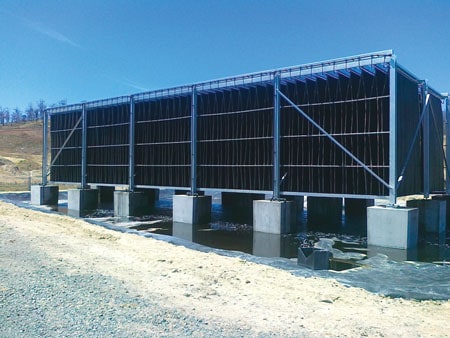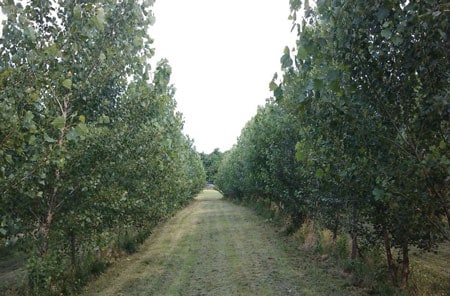As the concern of impacting our planet’s water resources and atmosphere continues to grow stronger, more and more responsible entities are seeking sustainable solutions to proudly face their community and investors and announce that they are doing their part to help tackle these issues. Natural systems are one possibility worth exploring.
By Eric Wiediger
Leachate: The ugly word that always has and will give landfill operators, environmental managers and corporate accountants headaches. It is the landfill juice that slurps up annual budgets and can become an enormous environmental problem in a matter of minutes. Just reading about it makes many of us cringe. So, what if there was a way to make leachate sexy? Well perhaps not sexy, but how about a solution that not only eases the minds of staff, but can also create a positive and green project worth bragging about to colleagues and, dare I say, the community?
Natural Systems
I am talking about “Natural Systems” for onsite leachate management. If you are not aware of them, they have become an interesting trend picking up within the solid waste industry over the last 10 years. From using plants to consume leachate to maximizing wind evaporation with wholly new methods to reduce volume, natural systems can provide a cost-effective and low-energy solution for onsite leachate disposal. Like many treatment and disposal options, they are not a one-size-fits-all answer for every facility out there; however, when site conditions are favorable, they can prove critically beneficial for a landfill owner.
How can a natural system help a landfill? First, let’s back up like a tanker truck easing into a busy wastewater treatment plant. Management of leachate can often be split into on and offsite strategies. Hauling to a wastewater treatment plant (WWTP) used to offer an attractive out-of-sight, out-of-mind solution for many landfills. Recently, however, WWTPs are being forced to tighten up their incoming waste streams in response to changing discharge limits, operational cost increases, complications with UV disinfection, and the rise of hard-to-treat contaminants like pharmaceuticals and Per-and Polyfluoroalkyl Substances (PFAS), which can pass through and end up in our rivers and streams. With the advent of EPA’s e-manifest program in June 2018, WWTPs in some states are also now required to track and pay a fee for every load of non-hazardous leachate that they receive. For any of these reasons, a landfill can quickly be cut-off, making them frantically in search for an alternative. Therefore, any method which can reduce, or even eliminate, the dependency upon WWTPs is worth considering.

Onsite leachate systems typically include evaporation ponds, recirculation and treatment plants. If you are not located in an area with high evaporation rates or permitted to recirculate, your options may be limited to your very own wastewater treatment plant, which can come with high capital and operational costs.
Natural systems, on the other hand, can remove the most common problems associated with traditional leachate treatment and disposal. It does not involve hauling, dependency on a WWTP or high energy use. They use technologies that strategically take advantage of and leverage the ability of natural processes such as wind, solar, plants, evaporation and biological activity. The systems are installed at the facility, often in the landfill footprint and already contained within a liner system. As the saying goes, pollution is just a resource out of place, and natural systems help realign that cycle.
Phyto-Utilization
What exactly is a natural system? A constructed wetland is what many people first think of when they hear the term, and indeed in the right scenario it can be a powerful tool for flow-through treatment to meet effluent discharge limits of certain compounds. Over the last decade, additional natural systems have been developed and successfully implemented across the solid waste industry. These newer systems focus on disposal (e.g. volume elimination) of leachate or industrial wastewater. One example is phyto-utilization™ technology (see Note 1), which is the use of specially selected plants with high water demand and high tolerance to the harsh conditions typical of leachate to consume liquid waste to greatly reduce or eliminate the need for other disposal methods. In this setup, the leachate becomes a resource, with the liquid used as moisture for the plants and the contaminants act as micro and macro nutrients to fuel fast growth.

A phyto-utilization system typically includes a fully automated control and distribution system that pumps the liquid from a storage pond or tank and irrigates the specialized plants. The plants absorb the moisture and use contaminants as nutrients in the natural growth process. It is a natural solution to a practical problem. Because these systems combine various fields of discipline such as environmental engineering, agronomy, soil chemistry and many others, they can be said to provide a holistic, innovative approach to leachate disposal. Once installed, plant-based systems typically require much less maintenance and energy compared to traditional options, resulting in significant long-term savings, which have proven to often exceed 50 percent.
Wind Evaporation
If space is limited, an enhanced wind evaporation system might be right for your facility. One unique Israeli technology is starting to make “waves” in the U.S.: Wind Aided Intensified eVaporation, also known as WAIV™. It has been used throughout the world in desalination and now has been adapted to suit the solid waste industry. The fundamental principle of WAIV is to create a high density of wetted surface area within a small footprint, then wind naturally passing through the specially designed fabrics causes intensified and rapid evaporation of large amounts of liquid. WAIV is a proprietary technology and, like phyto-utilization systems, requires specialized engineering and oversight.
Regulatory Approval
By now, you might be wondering how difficult it is to gain regulatory approval for a natural system. Since the system design is site-specific and each state is different, permitting methods vary. An integral part of the design and approval phase of a natural system is communication with the regulatory agency to provide ample opportunity for the actual permit writers to develop a solid understanding of a given technology and to be able to have any questions or concerns directly addressed. This typically is accomplished with a face-to-face meeting and presentation of the technology. The good news is that experience to date shows a clear and positive trend of acceptance. Overall, regulators have been excited about the prospects of approving new technologies which reduce carbon footprint and impacts on communities, and typically the meetings conclude with the permit writers eager to find the best possible path for regulatory approval.
A Good Fit
If your facility is fortunate enough to be a good fit with a natural system, public relations opportunities are endless and to date, multiple projects have been featured in the corporate sustainability reports of large companies. The systems can create wildlife habitat, improve aesthetics, remove tanker trucks from the roads, and provide positive news for neighbors. They also lower environmental impact by reducing a facility’s carbon footprint, remove diesel emissions caused by hauling and reduce corporate environmental liability. These systems also require much less mechanical power to operate than traditional treatment plants, cutting down on energy use and related costs.
As the concern of impacting our planet’s water resources and atmosphere continues to grow stronger, more and more responsible entities are seeking sustainable solutions to proudly face their community and investors and announce that they are doing their part to help tackle these issues. Natural systems are one possibility worth exploring.
Eric Wiediger is a Senior Project Manager at Leachate Management Specialists, LLC with 13 years of experience in solid waste management in both public and private sectors, including design, permitting, and operation of natural systems for leachate and regulatory oversight of enforcement cases involving municipal, industrial, and hazardous wastes. He also served as a Peace Corps environment volunteer in Mongolia. Eric can be reached at [email protected] or visit www.leachate.us.
Note
1. Offered by Leachate Management Specialists.
